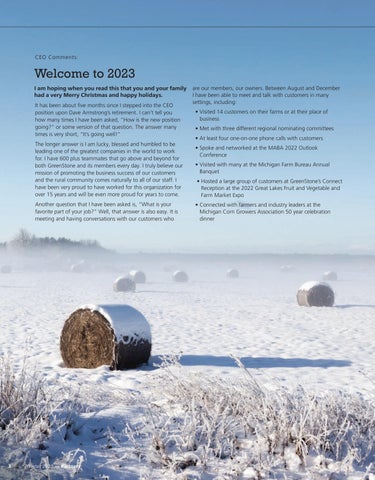

WINTER 22
5 YBSF Feature. Most days, Anthony Wender of Iron Mountain, Michigan is awake and on the job before the sun rises and doesn’t make it back home until well after dark. That’s the reality of the logging industry. It takes hard work and determination to harvest timber. 21

19 GreenStone Story.
Each year, GreenStone’s appraisal experts re-appraise parcels of land to understand the trend of how much real estate values have shifted.
21 GreenStone Story.
We all have room to learn and grow, and it’s part of GreenStone’s mission to provide opportunities for both new and experienced customers to do just that.
31 Crop Insurance Feature.
For nearly 100 years, the Gross family in Weidman, Michigan near Mount Pleasant has been running a dairy operation.
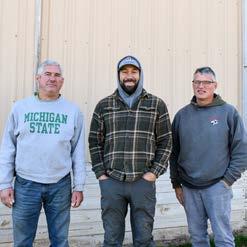
35 Tax Feature. Tax accountant experts anticipate the use of farm income averaging to increase this year. Here is a basic overview of the filing option.


3 CEO Comments.
President and CEO Travis Jones checks in on his new roll with GreenStone and shares goals for 2023.
11 Market Outlook. Wrapping up 2022 and looking ahead to forecasts for the new year.
18 Member Patronage.
On March 16, GreenStone staff and members will celebrate together while handing out checks to members totaling $120 million!
23 Legislative Matters. When it comes to achieving measurable results toward sustaining human existence, what all humans need is food. If society cannot get food right, what else matters?
24 PAC Progress.
Your MI GreenStone PAC and WI Farm Credit PAC finished 2022 strong with meetings and checks being delivered to both Senate and House of Representative legislators and 2022 candidates.
25 Guest Column.
With the end of deer season, use this time of year to focus on scouting, habitat improvements, and tree stand maintenance
27 Winter Hydration.
During the cold winter months, experts say make hydration a priority and your body will reward you.
29 Crafting Away the Winter Blues.
37 Family Account and Sharing. As parents we must be aware of what our children are doing online and talk with them, letting them know what is appropriate to say to people they might meet online. 8 CultivateGrowth
8 Agriculture Blog Brief 9 YBSF Resources 10 MAEAP 14 Member News 15 Calendar of Events 16 Pause for Applause 17 Behind the Scenes 22 Candid Comments 26 Country Living Blog Brief 28 Commodity
30
Publisher’s Note:
As Christmas Day wraps up each year, my kids always share how their stockings were once again their favorite part of Christmas morning. Sure, they may pick one of their gifts as their most cherished “item,” but the socks bring the experience they most value. Why? How could a random array of tchotchkes, hats and snacks accomplish this?
I have to believe it’s not only the custom selection of items uniquely important to each of them, but more so the rapid succession of excitement that comes one item after the next as they dig toward the bottom of the sock – a joyful experience remembered more by the way they felt than the items themselves.
Isn’t that true of most experiences? Anthony Wender speaks of timber harvesting as a lifestyle he grew to love by spending countless hours with his farther an uncle. (page 5)
GreenStone’s senior VP of credit, Brad Wright, discusses the experiences of 2022 resulting in 2023 market outlook expectations. (page 11)
The Patronage checks each year are a valued member benefit, while the celebration in the branch on Patronage Day – March 16th this year – brings the more cherished experience. (page 17)
A series of educational sessions, networking opportunities and informative events hosted by GreenStone over these winter months provide you with more than two dozen beneficial and impactful experiences. (page 21)
The personal relationship formed over the years with their GreenStone team led the Gross family to expand their partnership with GreenStone to include crop insurance as they make a significant farm transition. (page 31)
We believe your experience shouldn’t only be about the product or service, but the ongoing touchpoints and personalized solutions that provide you with support and satisfaction time and time again.
And, we hope this publication brings you another memorable experience as you read and embrace the new year!
– Melissa
Editorial
Cassie Bowman
Amber Echlin
Markie Heideman
Melissa Rogers
Amber Zabonick
Art & Design
William Eva Hailey Gilbert Greg Ricker
Partners
GreenStone Farm Credit Services 3515 West Road East Lansing, MI 48823 800-444-3276 marketing@greenstonefcs.com
Welcome to 2023
I am hoping when you read this that you and your family had a very Merry Christmas and happy holidays.
It has been about five months since I stepped into the CEO position upon Dave Armstrong’s retirement. I can’t tell you how many times I have been asked, “How is the new position going?” or some version of that question. The answer many times is very short, “It’s going well!”
The longer answer is I am lucky, blessed and humbled to be leading one of the greatest companies in the world to work for. I have 600 plus teammates that go above and beyond for both GreenStone and its members every day. I truly believe our mission of promoting the business success of our customers and the rural community comes naturally to all of our staff. I have been very proud to have worked for this organization for over 15 years and will be even more proud for years to come. Another question that I have been asked is, “What is your favorite part of your job?” Well, that answer is also easy. It is meeting and having conversations with our customers who
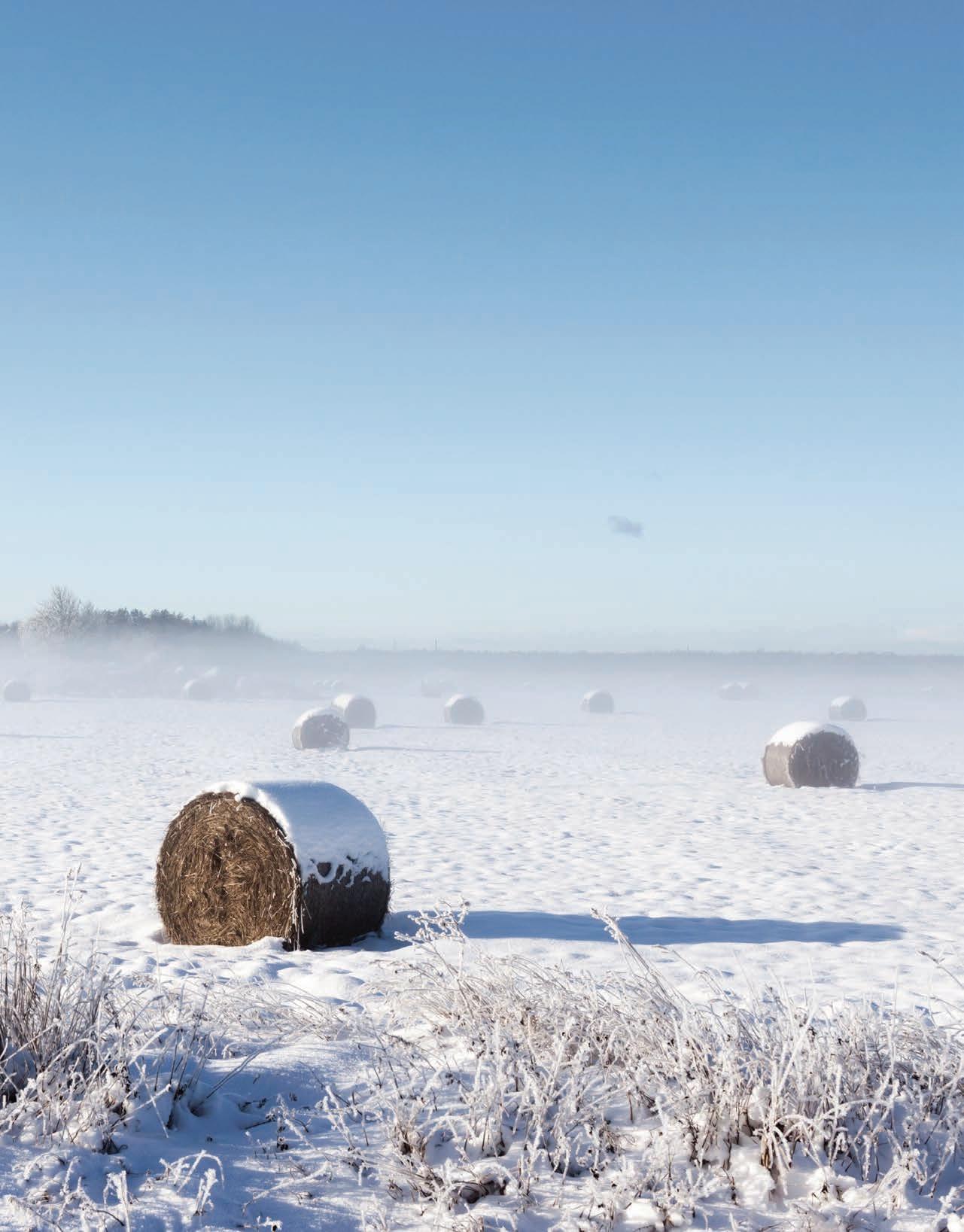
are our members, our owners. Between August and December
I have been able to meet and talk with customers in many settings, including:
• Visited 14 customers on their farms or at their place of business
• Met with three different regional nominating committees
• At least four one-on-one phone calls with customers
• Spoke and networked at the MABA 2022 Outlook Conference
• Visited with many at the Michigan Farm Bureau Annual Banquet
• Hosted a large group of customers at GreenStone’s Connect Reception at the 2022 Great Lakes Fruit and Vegetable and Farm Market Expo
• Connected with farmers and industry leaders at the Michigan Corn Growers Association 50 year celebration dinner
I even talked with a couple of customers at my aunt’s (Lois Boone) funeral visitation at the end of November.

The one thing I hear when talking with all of these members is how proud and happy they are to be part of and work with GreenStone! I get such a good feeling every time I hear great things about GreenStone from our customers – our members. It is definitely the best part of my job.
I also won’t deny another great part of my job is highlighting the cooperative's strong financial results. For 2022, we earned record net income of over $280 million. That income was driven by our customers’ outstanding credit quality, strong loan growth of almost 10%, another very good year of providing value added support by our financial services teams, and operating your association in a very efficient manner. While we won’t have the final comparisons until mid-February, I strongly believe we will have the best overall financial results in the Farm Credit System in 2022 of any Farm Credit association.
While all four of our lending lines of business (traditional agriculture, agribusiness, country living and capital markets) saw their loan balances grow in 2022, the results from our capital markets business really carried the bulk of the water with approximately 30% loan growth. The team accomplished this feat of strong growth through excellent financial solutions and customer service all while being understaffed a significant portion of the year. Our lending lines of business seem to take turns having the higher percentage of the loan growth each year. That is the value of a diversified portfolio and is key in our business plan. I can’t thank our sales and credit teams enough for their hard work and our customers' business management and partnership with GreenStone.
Help me out here…every year for the last 18 years, when we have strong earnings we get to share something with our members. What is it? Trying to remember. Oh yeah, Patronage! In midDecember your Board of Directors approved a record Patronage payment of $120 million to be paid in March. Our total cash Patronage paid over the last 18 years is now $840 million. That means the average amount paid back to our members as a percentage of your loan balance will again be nearly 1.25%. What a tremendous benefit to the members of our cooperative when we can share the success of our financial institution with our customers.
I continue to talk with our Board of Directors and our management team about GreenStone challenging ourselves in the areas I feel this organization needs to excel to consider ourselves to have had a “championship” year. In my mind, it’s three things: Financial Performance, Customer Satisfaction and Employee Engagement. I have already discussed how well we performed financially in 2022. In the fall issue we shared our strong 95% customer satisfaction score for 2022.
In the third area, our employee engagement scores have been strong all year, but we recently received some outstanding recognition by the Detroit Free Press (Free Press). On November 20th, the Free Press announced their Top Workplaces in the state of Michigan. They described the heart of their ranking was based on a 24-question survey sent to employees. Well, for 2022, GreenStone was ranked number 4 in the state in the Large Top Workplaces category (companies having more than 500 employees). Our management team and our human resources department, and our entire work family are very proud of this recognition. We know the importance of having engaged, happy teammates. Employee
engagement will continue to be one of our top priorities for years to come. Each of these three areas all directly impact the success of the other areas, engaged employees deliver strong customer service which positively impact financial quality.
With the overall results we have produced in 2022, I want to declare 2022 as a Championship year. Your cooperative has checked all the boxes with Financial Performance, Customer Satisfaction and Employee Engagement to be categorized as an outstanding year!
Now, just like you, we have to figure out how to do it again in 2023. Net farm income in 2022 is forecast by USDA to increase 13.8% over 2021 to $160.5 billion. Adjusted for inflation, this puts net farm income for 2022 at its highest level since 1973. The USDA will make its first forecast of 2023 farm income in February. However, the Food & Agricultural Policy Research Institute (FAPRI) is projecting net farm income in 2023 will fall back to $135.8 million, or a decline of 15%. They also predict another 9% drop in 2024. Every year is a challenge for our members. 2023 will certainly have its challenges with extremely high fuel and input costs, labor issues and higher interest rates.
As my old boss used to say, many of our customers have “built some altitude” over the last couple of years. This altitude in your balance sheets will help in 2023. You all have handled these types of pressures in the past and you will handle it again in 2023. GreenStone has also seen these pressures over the last 107 years and will be here to work with you again, whenever you need us. Thank you again for your membership and business! Please feel free to reach out to me any time if I can ever be of assistance.
Travis Jones 517-318-4144 travis.jones@greenstonefcs.com

I get such a good feeling every time I hear great things about GreenStone from our customers—our members. It is definitely the best part of my job.
“

A NEW GENERATION OF TIMBER
Most
That’s the reality of the logging industry. It takes hard work and determination to harvest timber.
Anthony knew that going in, though; it is in his blood. His grandfather started logging after serving in the United States military in Korea. His grandfather then passed down that passion to his two sons, who continued the family-owned logging company.
Anthony worked for his father and uncle's logging company as a piece cutter until 2018. He then branched out on his own and started piece cutting for another company, and eventually started harvesting lumber for that company in 2021. That's when he began working with GreenStone to secure a loan to get his hands on his own harvester.
“You grow up around it and it becomes familiar, and you grow to love it and it honestly doesn’t even feel like work,” said Anthony. “It’s a passion.”
He met with Cameron Rowe, a financial services officer at GreenStone who specializes in timber. Cameron was excited to work with Anthony because he knows just how important recruiting a new generation of loggers is.
➡ Anthony Wender works from before sunrise until after sundown most days harvesting lumber; a passion he has had for years.
“We have a lot of tools available, especially for young people, and we’re eager to work with them because we know we need to help get young blood into the pipeline.”
That toolbox is a part of GreenStone’s CultivateGrowth program. GreenStone’s financial service officers have a variety of options to help young, beginning and small farmers and timbermen. Solutions may entail partnering with the Farm Service Agency or utilizing GreenStone’s exclusive financing options and expanded resources to help secure long-term fixed interest rates and reduce down payments for new and upcoming farmers and loggers.
Anthony was able to take advantage of these benefits to secure his equipment loan.
“It was just a simple phone call, and they helped me with the rest,” said Anthony. “Working with Cameron has been a positive experience!”
Once the deal was done, Anthony hit the ground running, sometimes working seven days a week on logging jobs in Michigan’s upper peninsula and northeast Wisconsin.
days, Anthony Wender of Iron Mountain, Michigan is awake and on the job before the sun rises and doesn’t make it back home until well after dark.
➡
“I’m contracted to show up and harvest the timber,” said Anthony. “It’s a simple idea.”
A simple idea for a guy working hard to make sure he has secured enough work to keep doing what he was born to do.
“Up here, it’s all about how much contract you can get with the mill,” said Anthony. “Right now, business is booming and I definitely won’t be looking for new work any time soon.”
And he’s already looking to the future.
“I was just kicking around the idea of getting another harvester,” said Anthony. “There’s a lot of capital up here.”
When he does decide to take that leap, GreenStone will be here to help him every step of the way, from business planning to financial solutions
“We have seen him grow as an employee with a chainsaw to now a harvester and we can’t wait to see what he does next,” said Cameron. ■
Anthony was able to work with GreenStone to secure financing for his harvester that he uses everyday.

Up here, it’s all about how much contract you can get with the mill... Right now, business is booming and I definitely won’t be looking for new work any time soon.
“
GETTING STARTED WITH CULTIVATEGROWTH
As a part of our investment into the future of farming, GreenStone’s CultivateGrowth program provides opportunities for young, beginning and small producers to start their own operations.
How Do I Qualify?
You can qualify for a CultivateGrowth loan if you are: a young farmer under 35, have less than 10 years of farming experience, or earn less than $250,000 gross farm income per year.
What are the Perks?
Loans: Being a part of the CultivateGrowth program means you could qualify for loans
with more relaxed financing standards. Our CultivateGrowth Emerging Loans also provide the opportunity to earn an even lower interest rate!
Grants: GreenStone also offers grant opportunities for reimbursement of many of the activities and resources that will help them learn and grow their business – including educational opportunities.
Building a Network
To prepare the next generation of industry leaders for success, GreenStone is working to connect producers through the CultivateGrowth Mentorship. New and experienced farmers of similar interests
and farming practices are paired to help share industry knowledge, pass along onfarm lessons, and help equip them for the challenges of the agricultural industry.
Getting Started
GreenStone wants to help farmers every step of the way, and we’re here for them in the beginning, middle, and end of their agricultural careers.
To learn more information on how to take advantage of our CultivateGrowth program, visit greenstonefcs.com/cultivategrowth or reach out to your local branch! ■
➡
➡
iAGRICULTURE – OPEN FIELDS BLOG BRIEF
GreenStone publishes regular updates on our Open Fields blog. Check out some of the posts you may have missed at www.greenstonefcs.com/openfieldsblog.
Timber! Making Your Logging Dreams a Reality
When you’re ready to take your logging operation to the next level, GreenStone can help!
Dollars and Sense: Land Benchmark Results
Each year, GreenStone re-appraises parcels of land to understand the trend of how much real estate values have increased or decreased.
Private Party Purchases
In today’s high dollar, high demand equipment environment producers are turning to alternative avenues to meet their operation’s machinery needs at the most affordable price. ■
Top Left: The Schultzes' australian shepherd, Miles.
Bottom Left: GreenStone financial services officer, Johnny Thompson, featured with Max and Halie Schultz
YBSF RESOURCES:
$40,000 AVAILABLE IN GRANTS
GreenStone understands and greatly values the role young, beginning, and small farmers and urban food producers play in sustaining rural communities and agriculture. To continue supporting the next generation of agriculture, GreenStone is again providing $40,000 to young, beginning, and small farmers through CultivateGrowth grants!
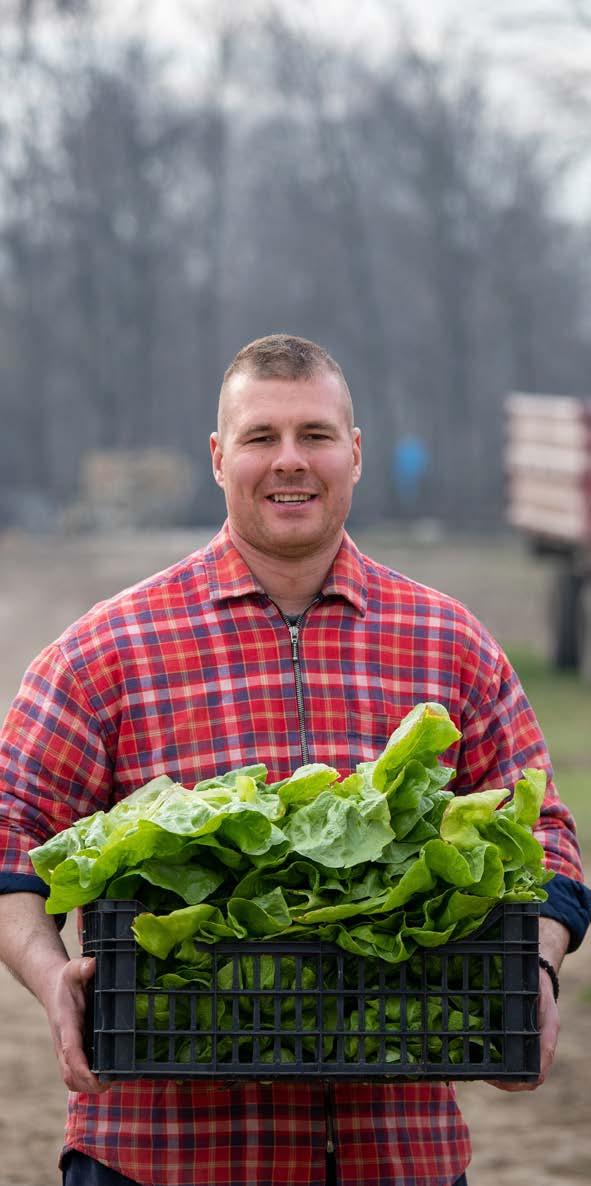
Whether you are starting a business from the ground up or taking over your family’s generational farm, you need the right resources and knowledge to overcome the challenges of today’s highly competitive market. Designed specifically to help prepare all producers for success, grant dollars can help minimize financial burdens and connect farmers with valuable resources. From farm consultations, attending national conferences, participating in local workshops or utilizing GreenStone’s tax and accounting services for the first time, this grant can be used to cover costs for a variety of agriculture-related educational opportunities.
2023 marks the sixth year GreenStone has dedicated $40,000 to individuals through grant funding. Grants are awarded up to $1,000 for current customers and up to $500 for nonGreenStone customers.
Eligibility:
• Young, beginning or small farmer
– 18-35 years of age, or
– Farming for less than 10 years, or
– Sustain annual gross sales from agricultural production of less than $250,000
• Must be eligible to be a member of GreenStone: reside in Michigan or northeast Wisconsin
Intended grant use must fall within one of the following categories:
• Agricultural programs/events: educational course/program (on-site or online), conference fees, etc.
• GreenStone resources: first time use of accounting and tax services, technology support, etc.
• Non-GreenStone services: business and farm consultants, etc. Interested in applying? Dollars are awarded on a first-come, first-serve basis so don’t wait to apply. Visit greenstonefcs.com/ grants for more information ■
CULTIVATEGROWTH MENTORSHIP: GETTING MORE OUT OF YOUR MENTORSHIP
a business, ultimately leading to endless connections and opportunities for both individuals.
The 2022-2024 CultivateGrowth Mentorship, the fifth and most diverse group of participants since its inception in 2015, launched in November 2022 during an in-person kick-off training event. During the kick-off, program facilitators advised participants on creating an effective mentorship and genuine relationship.
Focusing on generational differences, attendees were able to better understand their counterpart, allowing them to begin their mentorship journey.
Often times, life’s most impactful –and sometimes toughest– lessons are learned through experience. This is also very true in agriculture and for new or beginning farmers these lessons are priceless. Rather than learning these lessons the hard way, beginning farmers have a chance to gain experience-based knowledge quickly through GreenStone’s CultivateGrowth Mentorship.
Through this program, beginning farmer mentees who are eager to learn have been paired with an experienced farmer mentor to gain valuable knowledge, industry insight and lessons from. Each mentor farms a similar commodity and has decades of life lessons already under their belt. This unique partnership opens the door for many insightful conversations about farming and managing
Following the training, mentors and mentees are encouraged to start with farm tours of each other’s operation, and connect frequently for conversations to answer questions, discuss challenges, share ideas, and provide guidance. These conversations lead to both the mentor and mentee learning from one another and often resulting in friendships lasting long after the program concludes.
Stay tuned for more updates on the current mentorship program and the unique friendships that often come from it. ■
2023 CultivateGrowth Conference
More than your average lender, GreenStone is committed to offering opportunities and resources beyond consistent credit and financial services. That’s why for the first time ever GreenStone is hosting a CultivateGrowth Conference to provide young, beginning, and small farmers a chance to expand both their network and knowledge as they move forward.
During this early March day-anda-half conference in Lansing, attendees will hear from several notable speakers, agriculture
leaders and industry professionals to help producers prepare for a successful year. Attendees can gain deeper understanding of financial fundamentals, valuable insight on risk management, best practices for tax and accounting, networking opportunities, business development and more!
The conference will kick off with an evening networking reception and attendees will hear from Greg Peterson, of the Peterson Farm Brothers on the power of social media and advertising yourself
and your operation. To kick off day two of the conference, attendees will hear from various industry professionals followed by Dr. Marissa Hake, a well-known calf vet, agriculture advocate and rancher.
If you are interested in attending this exclusive event, reach out to your financial services officer for more information. ■
Winter Market Outlook:
Breaking It Down
By: Brad Wright, Senior VP of Capital Markets & Agribusiness Lending CreditReal consumer spending continued to soften, and construction spending was very weak with the climb in interest rates. However, investment spending remained firm in the third quarter report. Other indicators such as strong demand for automobiles and a tight labor market provide reason for some optimism around future economic activity. However, with

Following two consecutive quarters of negative gross domestic product (GDP) growth, GDP grew by a 2.6% annualized rate in the third quarter of 2022. Much of the gain came from a large upswing in trade, while beneath the surface the economy is still losing momentum in both growth and inflation.
substantial fiscal headwinds remaining in place, a strengthening U.S. Dollar, and higher interest rates, GDP growth is likely to continue to be very soft. As of this writing, August and September manufacturing and services Purchasing Managers’ Indexes have confirmed broadbased weakening in the economy.
The October jobs report showed the economy continues to make progress in easing labor market tightness. The recent pace of job growth remains firm at 261,000 but has moderated, and wage growth continues to run at a more modest pace of 0.4% month-over-month. Private sector job gains were broad-based with the manufacturing, professional services, and health care sectors showing the strongest growth. With the unemployment rate at 3.7% as of October in combination with job openings remaining stable and continued progress on job gains, a more balanced labor market could help dampen some wage-related inflationary pressures.
All measures of inflation continue to surprise expectations to the upside. After a string of upside surprises throughout 2022, the September Consumer Price Index rose 0.4% month-over-month. The September Consumer Price Index report also indicated that year-over-year inflation eased slightly to 8.2% in September, down from 8.3% in August. While energy prices have moderated from their peak levels earlier in the year, other areas of inflation, such as food prices, services, and housing remain elevated.
Growth in global trade volume is expected to slow to 1.0% in 2023 and global GDP is expected to increase by 2.3% in 2023. Trade and output will be weighed down by several related shocks, including the Russia-Ukraine war, high energy prices, inflation, and monetary tightening. Global energy prices rose 78% year-on-year in August while food prices were up 11%, grain prices were up 15%, and fertilizer prices were up 60%. The Russia-Ukraine war has pushed up prices for primary commodities, particularly fuels, food, and fertilizers. In the second half of 2022, global energy prices were up 78% yearover-year, led by natural gas, which was up 250%. A 36% increase in the price of crude oil over the same period was small by comparison but still significant for consumers. While the supply situation for grains may not be as dire as some had
feared at the start of the Russia-Ukraine war, it is still a cause for concern.
Persistent inflationary pressures have caused the Federal Reserve to accelerate its policy rate hiking trajectory. At its November meeting, the Federal Open Market Committee announced another 0.75% increase in the federal funds rate to a targeted range of 3.75%-4.00%. In its updated market guidance, the committee is now signaling that the magnitude of the overall rate increases needed to tame inflation could potentially be higher than the 4-5% range it signaled in September.
The tone of the committee remains hawkish with a focus on taming inflation that runs well above its 2% target. Strong job growth and persistent excess demand for labor suggest a soft landing is still possible. However, aggressive tightening by the Federal Reserve keeps the likelihood of continued recessionary trends elevated through the coming year.
The USDA forecasts total farm cash receipts to increase 21% to $525 billion in 2022.
Total crop receipts are forecast to increase by 15%, with a 31% increase in soybean receipts, a 17% increase in corn receipts, and a 34% increase in wheat receipts accounting for most of the forecasted growth in crop cash receipts. Total animal product receipts are expected to increase by 28% with increases in receipts for all commodity categories.
Total production expenses are forecast to increase by 18% to $437 billion in 2022.
All categories of expenses are forecast to be higher in 2022, with feed and fertilizer purchases expected to see the largest dollar increases. Farm sector equity is expected to increase by 10% to $3.34 trillion in 2022.
Farm sector assets are forecast to increase 10% in 2022 to $3.84 trillion driven by
increases in the value of farm real estate. Farm sector debt is forecast to increase 5% in 2022 with debt-to-asset levels improving slightly to 13% in 2022 from 14% in 2021. Working capital is forecast to fall by 3% in 2022.
The United States farm real estate value, a measurement of the value of all land and buildings on farms, averaged $3,800 per acre for 2022, up 12% from 2021. The United States cropland value averaged $5,050 per acre, an increase of 14% from the previous year. The United States pasture value averaged $1,650 per acre, an increase of 12% from 2021.
Several lasting snow events across the upper Midwest in mid-November brought fieldwork to a halt, according to the USDA. Corn producers reported there was plenty of corn for grain left to be harvested, but harvest progress slowed as snow remained; moisture content at harvest was reported as 18 percent. Winter wheat emergence progressed ahead of its 5-year average and remained in good to fair condition; growth and development of wheat and other cover crops were at a standstill due to the cold weather. Soybean harvest was nearly complete, with reporters indicating only few scattered acres remained unharvested.
In its November Crop Production report, the USDA increased its yield forecast to 29.1 tons per acre. This reflects a 12% decline from last year’s record high of 33.2 tons per acre and would be the lowest since 2014/15 (27.3 tons). With the yield decrease, 2022/23 sugarbeet production is reduced to 33 million short tons. With the percentage of sugar recovered from the sliced sugarbeets and the quantity of sugar extracted from molasses unchanged from prior estimates, beet sugar extracted in crop year 2022/23 is projected at 4.5
The recent pace of job growth remains firm at 261,000 but has moderated, and wage growth continues to run at a more modest pace of 0.4% month-over-month.
million short tons raw value. This would imply an 8% reduction from the prior crop year.
The USDA’s all-milk price forecasts for 2022 and 2023 have been lowered due to recent downward trends in dairy product prices and larger expected milk supplies in 2022. The all-milk price forecast for 2022 is $25.50 per cwt while the all-milk price forecast for 2023 is $22.60 per cwt. The milk production forecast for 2022 has been raised, but the 2023 forecast is unchanged as lower expected milk cow numbers offset higher yield per cow. The U.S. dairy herd is projected to be 10,000 cows fewer in 2023 at 9.4 million head. The 2023 forecast for milk per cow is 24,350 pounds, 30 pounds higher. The projection for 2023 milk production remains unchanged at 229 billion pounds.
Wholesale price forecasts for Cheddar cheese, butter, NDM, and dry whey are $1.97, $2.45, $1.40, and $0.48 per pound, respectively. With lower projected wholesale prices for cheese and steady prices for dry whey, the Class III milk price forecast for 2023 is $19.65 per cwt. Due

to lower NDM price forecasts more than offsetting higher butter prices forecast, the Class IV milk price projection for 2023 is $20.35 per cwt. The all-milk price forecast for 2023 is $22.60 per cwt, a decrease of thirty cents.
The Quarterly Hogs and Pigs report issued by USDA on September 29, 2022, showed year-over-year lower September numbers in all important inventory categories, as well as for all breeding metrics. In particular, the report showed that the inventory of all hogs and pigs was more than 1% last year, while the inventory of breeding animals was 1% below a year ago. The reduction in breeding numbers was the ninth consecutive quarterly decline since September 2020, meaning that in two years the U.S. inventory of breeding animals has lost approximately 181,000 head.
In addition to continued reductions in breeding animals, the September report showed that farrowings for the summer quarter, as well as producers’ farrowing intentions for the fall and winter quarters, were both below those of a year earlier. Continued reductions in breeding
inventory numbers, farrowings and intended farrowings are notable, given positive producer returns published by Iowa State University. Producer reluctance to expand production capacity may be a collective response to perceived uncertainty about the U.S. and world economies and to the potential implementation of State laws—in California in particular— that could affect most U.S. hog production models.
Confirmations of Highly Pathogenic Avian Influenza (HPAI) in meat turkeys continue to be reported, with a case involving 18,500 meat turkeys as recently as November 10th. In total, 2.5 million commercial turkeys have been depopulated in the second wave and 5.6 million were lost in the first. Based on recent HPAI losses, forecast fourth-quarter turkey production was adjusted down to 1.3 billion pounds. This would make the 2022 annual production forecast 5.2 billion pounds, a decrease of 7% from 2021. Forecast 2023 production is 5.6 billion pounds, an increase of 8% from 2022 but less than 1% above 2021 production. ■
NEWS:
It is now a part of Michigan State University Extension (MSUE) and is a place for growers to gather, get information and learn about the specific needs of plants and soil in Oceana, Mason, and Newaygo counties.
Inside the building, you will often find MSUE Educator Emily Lavely. Equipped with a research background in root and tree health, she was excited to join the team at the station – especially because West Michigan crops have different needs than others in the state. She wanted to get to the bottom of those specific needs and help area farmers grow the best crops possible.
This past season, more than 6,000 trees were planted at the station. That includes new apple varieties, sweet cherries, peach and pear trees. These trees will soon be evaluated to recommend new varieties, rootstocks, and growing practices that are best suited for the area.
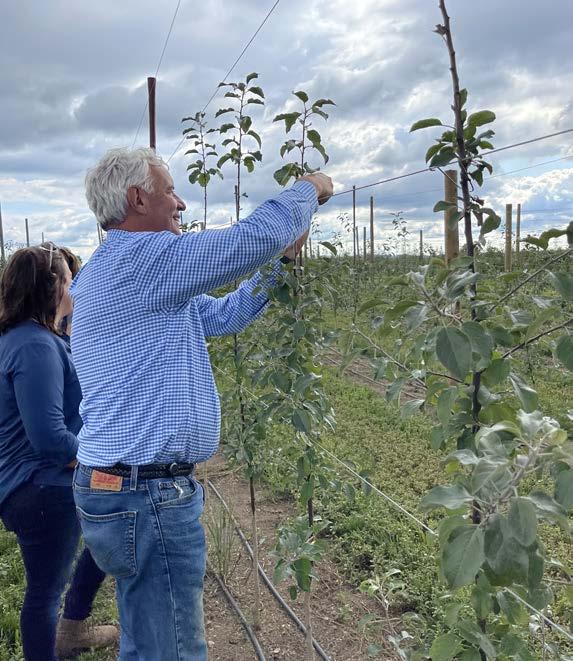
“I feel incredibly privileged to be able to work with the growers here and have this resource here and have the support of the board,” said Emily. “It’s something I’m very thankful for and I look forward to continuing supporting growers for years to come.”
That support includes board president Andy Riley. A farmer himself, Andy was part of the group that came up with the vision for the station. He said he never expected the center to come together so quickly, but
RESEARCH
thanks the community for their unwavering support because most of the funding for the station comes from donors.
“The thing I tell people I’m the proudest of is when you walk in the front door, you can see the people and the organizations that got behind the project on display,” said Andy. “The success of the station depends on the support of the community staying engaged in the research station. The partnerships we have established – many people are annual donors.”
GreenStone is one of those partners. The cooperative is committed to going the extra acre for our members and the farming community, and that includes investing in horticulture research.
The station is proud of the community’s support, so in return, they are proud to serve the community. The center is for research purposes first but also serves as a community center. They have opened their doors for things like blood drives and celebrations, and even housed some court hearings during the COVID-19 pandemic when the county needed a larger area to spread out.
The future of farming depends on help from the community, knowing best practices, and sharing ideas. That is what is happening inside the doors of the West Michigan Research Station.
GreenStone is proud to be a part of this legacy. ■
GreenStone Scholarships: $60,000 Available!
GreenStone is committed to supporting the agriculture industry’s future leaders and is happy to once again award up to $40,000 through the annual 2023 scholarship program. Incoming college freshmen pursuing a degree in an agriculture-related fields are encouraged to apply now. Students planning to earn a four-year degree are eligible for a scholarship of $2,000 and students attending a two-year college program are eligible for a $1,000 scholarship.
NEW! In addition to our long standing incoming freshmen scholarship program, to honor GreenStone’s former President and CEO Dave Armstrong and his 41-year career-long commitment to agriculture at Farm Credit, GreenStone has established a new Dave Armstrong Scholarship. Up to $20,000 in scholarships is available for current college freshmen, sophomores, and juniors pursuing a degree in agriculturerelated fields in the amount of $5,000 each.
Applications are now being accepted for both programs. For complete program guidelines and application, visit greenstonefcs.com/ scholarships. Application deadline for both scholarships is February 28, 2023. ■
Annual Report Notice
This is an official notice that the 2022 GreenStone Farm Credit Services annual report will be available for viewing online at www. greenstonefcs.com by Thursday, March 16, 2023. In addition, the annual report will be mailed to all stockholders within 90 days of year-end. By regulation, GreenStone is required to send a copy to each stockholder, regardless of if it is a duplicate mailing address. ■
A vision for the West Michigan Research Station was set back in 2019, and thanks to the help of producers and donors in the community and across the state, the center broke ground in 2020.
HELPING A COMMUNITY GROW THROUGH➡ Pete Lemmer from GreenStone's legal team stops by the West Michigan Research Station to tour the crops.
PUTTING CUSTOMERS FIRST WITH NEW SALES LEADERSHIP STRUCTURE
GreenStone is proud to announce a new sales leadership structure that puts our members at the forefront. Three talented teammates have been appointed to lead sales and customer relations for the cooperative.
In the revised organizational model, a senior vice president will oversee each of the cooperative’s market segments: capital markets, agribusiness lending, and traditional agriculture and country living lending.
Nichole Wilcox: Senior VP and Managing Director of Capital Markets
Nichole Wilcox brings sixteen years of GreenStone experience as the new Senior Vice President and Managing Director of Capital Markets. For the past six years, Nichole
served as a Vice President of Lending and most recently as a Group Manager within our agribusiness lending segment. Before that, she served in roles at GreenStone including Credit Analyst, Lending Officer and Assistant Vice President of Capital Markets and Credit.
Nichole brings a wealth of well-rounded knowledge from several different segments, and is no stranger to capital markets. Her experience in this segment will benefit the diverse relationships across the nation and will help strengthen the overall team.
Ben Spitzley: Senior VP of Agribusiness Lending

Ben Spitzley has been a part of the GreenStone team since 2002. Most recently, Ben served as the Vice President and Group Manager of Agribusiness Lending – a role he assumed in 2012. During his decade in the role, he successfully oversaw a team serving dairy farms and related agribusinesses throughout GreenStone’s territory.
Before serving in that position, Ben held various roles within the company and brings a wide range of sales and leadership experience to the table.
Melissa Humphrey: Senior VP of Regional Sales and Customer Relations


For nearly two decades, Melissa Humphrey has served GreenStone customers, first as a Credit Trainee and then Financial Services Officer and, most recently, as the Regional Vice President of Sales and Customer Relations focused on GreenStone’s western territory. Now, she is taking a step forward and has accepted the role of Senior Vice President of Regional Sales.
In addition to her full-time roles, Melissa has coled the country living segment for GreenStone. The segment saw impressive results during her tenure. Melissa’s expertise in leading a number of different teams at GreenStone will help make our solid sales team even stronger, which in turn, will benefit our customers. ■
JANUARY
GreenStone Closed In Honor of Martin Luther King, Jr. Day
DBA Dairy Strong Conference (18-19) Madison, WI
Great Lakes Crop Summit (25-26) Mount Pleasant, MI
GreenStone Producer Forum Adrian, MI
FEBRUARY
GreenStone Producer Forum Sandusky, MI
Winter Potato Conference (1-3) Grand Rapids, MI
Great Lakes Regional Dairy Conference (1-3) Frankenmuth, MI
GreenStone Producer Forum Little Chute, WI
GreenStone Producer Forum Portland, MI
GreenStone Producer Forum Mount Pleasant, MI
GreenStone Construction Seminars (Feb. 13 - March. 3) Various Locations
GreenStone Closed In honor of Presidents’ Day
Outdoorama; Suburban Showplace (24-27) Novi, MI
MARCH
GreenStone CultivateGrowth Conference (6-7) Lansing, MI
Dairy Forum Green Bay, WI
Patronage Day
Ultimate Sports Show (16-19) DeVos Place, Grand Rapids, MI
GreenStone Logging Forum Gaylord, MI
Dairy Forum St. Johns, MI
GreenStone Logging Forum Escanaba, MI
Wisconsin Public Service Farm Show (28-30) Oshkosh, WI
which provides plenty of space for new opportunities.
Mary has multiple goals for the new location. Firstly, she hopes to duplicate the nostalgic feeling the old farm had while also providing a modern approach that allows for a lot of hands-on interaction. The second goal is education. She plans to provide as much education as possible on production agriculture.
Pause for Applause...
CRITTER BARN –GROW WITH
US
The Critter Barn in Zeeland, MI is dedicated to connecting people of all ages and abilities with the natural world by teaching about farming and agriculture. Through hands on experiences with livestock, horticulture, and educational activities, the community has felt a new spark and inspiration for agriculture.
Beginning on a three-acre homestead of an old dairy farm in 1984, the Critter Barn has been able to make an impact on thousands of lives each year. When the Critter Barn first opened, it was home to a few old barns and a handful of different livestock. Mary Rottschafer, the founder, had three young children and was a schoolteacher at the time. “We started doing school field trips and other small events. I was a schoolteacher, so it was just a natural transition that we weren't expecting when we first purchased the property. As the Critter Barn grew, we sorted things out in life so that it could be our main focus,” explained Mary.
Mary didn’t grow up on a farm, so this entire adventure has been a learning experience. “I always say I’m the best student, and I really relate to the people that visit the farm because I also had no agriculture background. I help them see how learning can be fun for all ages and learning about animal care or how our food is produced can be beneficial for everyone,” Mary said enthusiastically.
The mission and goals for the Critter Barn quickly outgrew the original location, and through the help of donations and sponsors like GreenStone, the Critter Barn recently moved to an all new 36-acre location
To do this, the new farm has buildings to demonstrate the modern management strategies and the reasoning for the advancements. “We want to educate people on how the ag industry runs their farms while also giving students the opportunity to work with real time equipment, management strategies, and technology,” explained Mary.
The third goal for the new location is agronomy. With multiple acres to work with, Mary plans to provide a plot for crops and demonstrate several natural resource management strategies such as water recycling and soil conservation. Through this plot of land, the public will be able to see the full cycle of farm to plate.
“There’s a local woman who is going to help us with the equipment to make flour from the wheat we’ve grown on the plot. That flour will then be used at a local bakery and will come back to our farm as food to eat,” Mary shared excitedly.
Lastly, the new Critter Barn will be universally accessible for people of all abilities. The designers are using an accessibility standards called universal design. Mary believes this may be the first facility in the United States that combines these opportunities with all the accessibility standards for people with disabilities or special needs.
The Critter Barn impacts the lives of 100,000 people each year, but with their new location they will be able to double that number and touch the lives of people for generations to come. Grow with them as they set foot on this next adventure!
For more information on the Critter Barn and their new adventure, visit their website at www.critterbarn.org. ■
The farming community always comes together in times of need! Grabemeyer Farms, Sprague Farms and many other friends and neighbors stepped up to help a fellow GreenStone customer get the corn and soybean crop out of the field this fall as a family medical emergency struck. It a proud moment seeing agricultural community looking out for each other!
SERVICE ANNIVERSARIES
Help GreenStone congratulate and thank these staff who are celebrating an employment milestone. From five to 30, the years represent the dedication and service all employees provide our members.
JANUARY
DiFranco 20 Thomas Moskal 25 Patti-Kay Niemi 30
FEBRUARY
MARCH
BEHIND THE SCENES
In this behind the scenes, two GreenStone employees share how their role allows them to support rural communities and agriculture.
Cameron Rowe Financial Services OfficerEscanaba, MI
3 Years of service
Describe how your role carries out the GreenStone mission of supporting rural communities and agriculture.
In my role as a financial service officer, I help support the agriculture and timber communities in the upper peninsula of Michigan (UP) by advocating for their businesses and ensuring that they have access to sound and constructively written credit and value-added financial services.

What do you enjoy about your role?
I enjoy the relationships I build with my customers and the fulfillment I get when I see their businesses and their supporting communities thrive amid all the headwinds and difficulties that come with calling rural America “home.”
What changes have been incorporated in your role to meet evolving customer needs?
I have grown accustomed to meeting my customer where they want to be served. Since the pandemic began, I have been able to do more virtual meetings with customers. Given the vast geographical area of my portfolio (all 15 counties of the upper peninsula), it has also been a godsend to be able to close loans electronically through DocuSign to save customers time and provide an added benefit of speed and agility to loan origination and servicing.
What do you enjoy doing in your free time?
I enjoy spending my free time with my growing family. We like to travel – especially internationally – and hope to do more of that in the coming years. I also relish the opportunity to spend time in the woods hunting big and small game back in my hometown of Saxon, WI.
Jordan Schafer Crop Insurance Specialist Alma, MI
4 Years of service
Describe how your role carries out the GreenStone mission of supporting rural communities and agriculture:
My role as a crop insurance specialist, carries out the GreenStone mission by first and foremost putting the customer first with above the bar customer service and followthrough. Our crop insurance products provide options for producers to put a “net” risk management in place to best suit their needs. I work to help each customer individually manage against each storm whether that be nature driven, or market driven, to remain successful in their operation.
What do you enjoy about your role?
What I most enjoy is working with such a diversified group of individuals. Each customer is different in how they do
things, and to build a wealth of knowledge from each one of these individuals is, in itself, very rewarding. Beyond that, the support from the entire agricultural community is hands down the most impressive thing to be witness to and observe. I love to build those relationships, and network with people.
What changes have been incorporated in your role to meet evolving customer needs?
Many different technological advances have been incorporated especially with precision ag/on farm data analytics, which all are being incorporated at a rapid pace to help in communication between agent and customer, all the way down through to reporting, and coverage decisions that are being made on a yearly basis. Also, the use of document retrieval/ sending with the incorporation of DocuSign, and Greenstone’s ability to drop documents to customers electronically has saved customers a lot of time.
Customers also appreciate GreenStone innovating through state of the art programs, such as the Optimum, e-vantage, and DRP analyzer tools that are exclusive to our customers, that analyze and depict on farm data to help growers choose the best coverage options for their operation.
What do you enjoy doing in your free time?
I enjoy spending time with my four kids and wife as much as possible. I also really enjoy being outdoors. I love to hunt and farm when I can. ■
Celebrate Patronage
#PartnershipPays – March 16, 2023
of our members and your trust in GreenStone. This partnership reflects our commitment to do all we can to assist our members through unprecedented times, seasons of profit and cycles of challenges.
will be prosperous long-term. Personal relationships and partnerships with our members are at the heart of our culture; it is what makes partnering pay in this very tangible way.
On March 16, GreenStone staff and members will celebrate together while handing out checks to members totaling $120 million! With a record $120 million in dividends being returned to members this March, there is a lot to celebrate!
Being a member-owned cooperative means our members benefit from our strong financial position. That’s why your board of directors elected to again increase your Patronage return this year from $115 million in 2022 to $120 million in 2023 –that’s remarkably over 40% of GreenStone’s 2022 net earnings and it’s all coming back directly to our loan customers, our members, in dividend checks on March 16.
This record-level Patronage is a direct result of the success
Each member will receive a notification letter in midFebruary in which you’ll learn the amount of your check. With the letter will be a personal invitation to join us in the celebration at your local branch, where you’ll be able to pick up your check and enjoy the festive fun with your local staff.
As a financial cooperative, it is necessary for GreenStone to generate strong earnings and maintain adequate capital levels to help ensure we remain a dependable source of credit for years to come. In support of its members, the cooperative continues to build and grow for the future. Record Patronage, earnings, and capital, combined with strong loan growth in 2022 and solid customer satisfaction and employee engagement, are just a few key reasons our partnership with members
Patronage Day is an opportunity to celebrate the many benefits of your cooperative membership. Come join us in the branch for food, connection, and fun and collect your member reward. ■ #partnershippays
When our members are successful, we’re successful; and once again that partnership is realized through Patronage!
The Value of Land Values
By: Andrew Warner, GreenStone VP and Chief AppraiserAside from the obvious benefit of simply knowing land values, it’s also important for our team to have a pulse on the market because a majority of a farmer’s wealth isn’t in their pocket or bank account, but in their land holdings. These appraisals also help growers, and their financing partners, understand underlying trends driving their land wealth.
Cash Crop - Southwest MI 1.9% 12.5% 20.0%
Cash Crop - Southern MI 15.0% 31.4% 53.3%
Transitional - Southeast MI 17.0% 39.2% 129.2%
Transitional - Southern Thumb MI 16.7% 20.0% 49.2%
Cash Crop - Mid-Michigan 10.0% 3.8% 15.8%
Cash Crop - Northern Thumb MI 18.1% 9.3% 43.4%
Cash Crop - Saginaw Valley MI 16.1% 12.2% 35.2%
Recreational - Northern MI 25.0% 56.3% 85.2%
Cash Crop - Southeast NEWI 19.6% 15.4% 45.3%
Cash Crop - Western NEWI 14.5% 22.1% 61.8%
Large Dairy - Michigan 9.8% 11.3% 32.5%
As part of this annual evaluation, research is done to understand why these values may be going one way or the other. A rise or decline in commodity prices, input costs, interest rates, weather, tourism and labor availability all play a part in determining the market value of real estate.
This past year saw volatility in these factors, ultimately resulting in property value increases, which overall is good news for GreenStone customers.
Cash Crop and Dairy
As seen in the chart, cash crop values increased 10% to 20% between July 2021 and July 2022, with the exception of the benchmark cash crop property in Southwest Michigan. That one benchmark was an outlier compared to the rest and increased less than 2% because it measures non-irrigated cash crop land in a rural area – largely lacking urban development pressure.
It’s no secret that crop prices have gone up over the past year, and in turn, farmers look to reinvest those profits into acquiring more land. The measured benchmark cycle (July 2021-July 2022) also saw a favorable interest rate environment, further increasing the ability to pay more for land acquisitions. While these factors primarily drove the measured increases, the RussiaUkraine conflict abroad also prominently factors into our markets at home.
Transitional and Recreational
Transitional land is in the same boat, experiencing an increase between 16% and 17%.
Transitional land can typically be considered rural crop land being converted to urban development. Also, recreational land value went up 25% - land used for hunting, outdoor recreation, etc.
In both market subsets, the desire for many work-at-home employees to live a more rural
lifestyle is largely considered the cause. The COVID-19 pandemic continues to push newly remote employees into the rural landscape, or just those looking for their own paradise in the outdoors.
Where do we Rank Regionally?
In the map below recently released by AgriBank, you can see how much farmland value has fluctuated from July 2021 to July 2022.
Most parts of Michigan saw between a 12% to 18% jump in farmland value, while Wisconsin saw an overall 18%
jump in all parts. Neighboring states in the region like Ohio, Indiana, Minnesota and Iowa saw larger jumps above 30% in some areas.
Regionally, no areas reported a decrease in farmland value. So, why is this good for land owners and potential land owners?
These increases are good news for land owners and those looking to purchase land. While the price to acquire land is now higher – your existing land holdings are also worth more in most situations than in
the past. Although it may cost you more now, acquiring land will likely continue to be a solid investment in your future.
It’s also important to note that this analysis was essentially concluded in July. Since that time, the factors described (interest rates, commodity prices, input costs, etc.) continue to experience volatility. However, resulting real estate values seem to be holding steady. As the new year unfolds, keep an eye on these ever-changing factors to determine where land values will go next! ■
Helping You Succeed in Your Field
We all have room to learn and grow, and it’s part of GreenStone’s mission to provide opportunities for both new and experienced customers to do just that.

Whether you’re getting ready to build your dream home, are working long hours on the logger, or are helping feed the globe through your crops, we know it can be difficult to keep up with industry changes, regulations, and new methods to increase efficiency. That’s why we are proud to provide opportunities throughout the year to help you network, learn new tricks of the trade, and become an expert in your field.
Let us do the research for you, and throughout our forums and conference, we will share important information that can help you become the best at your field you can be.
It's Time to Connect
Each year, hundreds of growers from across the great lakes gather in Mount Pleasant, Michigan for the Great Lakes Crop Summit. The two-day event provides attendees the opportunity to
learn more about the market, find out new techniques to take home to their farm and meet other growers across the area. If you are among this crowd, join GreenStone for a meal and drinks at our Connect Reception at the conference on January 25. It’s our thank you for being part of the GreenStone family.
If you’re a dairy farmer, we hope to see you at the Great Lakes Dairy Conference from February 2nd-3rd in Mount Pleasant. The conference includes sessions on employee management, calf care, manure management, and the state of the industry. GreenStone will also offer a Connect Reception during the conference for our members to network. Come enjoy food and drinks with us!
Focused Forum Fun
Knowing the state of your industry is important, and GreenStone offers plenty of opportunities to learn through our annual forums. We bring together a team of experts from each field to make sure you’re in-the-know about regulation changes, industry techniques and new inventions to make your job easier. Each set of educational opportunities are being held throughout Michigan and northeast Wisconsin to meet you where you are.
Producer Forums: Farmers need every tactic to protect your crops and most effectively run your farm. You’re invited to join us for Producer Forums this January and February. Members will learn more about farm financing, insurance options, tax and accounting advice, and the best methods for bookkeeping. You won’t have to drive far! Five forums will be held in Michigan’s Lenawee, Sanilac, Ionia, and Isabella counties, along with Outagamie County in Wisconsin. Check out our calendar of events on page 15 for full dates and locations!
Construction Seminars: GreenStone wants to help make your dream home in rural America a reality. That’s why, each year, we host a number of Construction Seminars in February and early March to share valuable information on construction financing. Our local teams provide expert insight on financing options and the construction draw process for your next big project, and provide advice on finding the best builder for your needs and tips for the entire project start to finish. In person and virtual sessions will be available to fit your individual schedule. Find all the details and register online at greenstonefcs.com
Timber Forums: For our members who have sawdust in their blood, we are glad to provide these opportunities to learn more about financing, bookkeeping, legislative updates and the state of the timber industry at GreenStone’s Timber Forums in March. Check our calendar of events on page 15 for this year’s dates and locations.
DRP Forums: Another way GreenStone is helping the dairy industry is through our Dairy Revenue Protection Forums also being held in March. We understand that the industry changes from year to year, and we are happy to provide this opportunity for members while also providing advice on bookkeeping and dairy financing. Watch for invitations and find out more on our website, greenstonefcs.com
Fueling the Future with Knowledge
We know the only way to keep food on the table across the globe is to invest in young, beginning, and small farmers. GreenStone’s CultivateGrowth program exists for that exact reason.
Young, beginning, and small farmers will join us in March for our first ever CultivateGrowth Conference. Members will learn valuable information to expand their business knowledge, manage balance
“ “
Thank you so much for your recent sponsorship of the MCLA Youth Challenge. As a sponsor, your contribution is vital to having kids continue showing livestock. We could not have had an awesome show year without you!
Curragh Cashen” ”
On behalf of the Farm Credit System Employee Relief Fund, I would like to thank you for your generous donation. Your contribution makes it possible to continue to provide financial assistance to others in need. This is only possible because of thoughtful contributions from people like you.
Douglas Stockham, President Emergency Assistance Foundation, Inc.
...Candid Comments
sheets, create business plans, tackling the financial side of things and learning the best bookkeeping tricks. Most importantly – this is an opportunity to network and learn from other farmers who face similar challenges and experiences across Michigan and Wisconsin.
We are here to help your farm and passion grow, and we are happy to provide this important resource.
We’re Here For You
Your success is our success, and we are proud to provide a number of opportunities each year to help take your business, farm, and home to the next level.
If you are interested in joining us for a conference, forum or event, reach out to your local branch for details. ■
Knowing the state of your industry is important, and GreenStone offers plenty of opportunities to learn through our annual forums.
Legislative Matters:
FARMERS GET IT DONE
When it comes to achieving measurable results toward sustaining human existence, what all humans need is food. If society cannot get food right, what else matters?
We can argue about all other things, and hold strong opinions about core values and issues, but at the end of the day, nutrition matters. Identifying the goal, taking measured action toward the goal with maintenance along the growth of the crop allows for real results.

There is a whole lot of detail and knowledge that allows for the successful outcome,
and those details came from generations of learning. Getting beyond the books and doing the work makes a successful farmer.
With all that gets accomplished for the good of society by farmers, all that we rely on happening, the world of agriculture continues to evolve. Hybrid seed development, aeroponics, aquaponics, hydroponics, tissue culture, drones,
robotics, and vertical farming are just a few of the sensible agricultural methods and technologies which are the future of food production. Constant progress is required and that comes from endless engagement with relentless action.
Learning to take reasonable chances outside a normal practice is one of the best skills anyone can develop. As a general group of professionals, farmers may be the most reasonable risk takers in business. As we know, the numbers of people in that profession are small in comparison, yet the risks they take each year are great. Those involved in agriculture know this to be true as it is a lived experience. Others read about it to get some appreciation for it. These others outside of actual production might even try to support it with “good” government policy and regulations, which farmers’ have experienced how that may or may not result in the intended support.
As agriculture leaders emerge and develop, the community must remain engaged and vocal. It will be our own voices that need be heard because of the lived experience we can share. To do this, we may need to be different than we have been in the past as the threats to being innovative become greater stifling growth. Just like sticking with what we know in agriculture production would ensure staying where we are in food production, so would sticking with were we are in how we communicate regarding our industry. To be innovative in production of food requires us to be innovative in how we communicate.
This will be particularly true as the policy leaders march toward embracing ideas coming from people who have not lived the experience of getting it done on the farm. We are on the eve of legislative leaders creating another Farm Bill. This Farm Bill and its accompanying regulations could dramatically effect how our food is grown. We need to evaluate both the little steps and big steps that must be taken to maintain agricultural sustainability to keep up with production demands.
Year after year, month after month, day after day, action has been taken by farmers and a complex network of support to get it done, delivered and digestible for others. ■
OUR VOICE CONTINUES TO GROW AND BE RECOGNIZED AS VALUABLE
Your MI GreenStone PAC and WI Farm Credit PAC finished 2022 strong with meetings and checks being delivered to both Senate and House of Representative legislators and 2022 candidates. All the planned disbursements were completed in Michigan and Wisconsin! The meetings were productive as connections were made and the cooperative structure of borrower-owned lending association was communicated.
At the Federal level, the legislative activities have been very dynamic from ag labor to the Farm Bill. The Farm Credit System, through individual Farm Credit associations and the Farm Credit Council, has been able to provide prospective as called upon. None of this would be possible without your engagement
and commitment to raise legislative awareness of rural communities, agriculture, GreenStone, and the Farm Credit System.
GreenStone will continue to build relationships for future support and strengthen the recognition of our members. Conversations will continue to take place in an effort to unite and expand our individual and collective legislative outreach efforts. The goal is to increase the awareness of the overall value of rural communities and the agriculture industry to our economies, and Farm Credit’s vital role in that. Your continued support is commended and we look forward to continuing to involve members in delivering these messages! ■
The MI GreenStone PAC and WI Farm Credit PAC annual drives are going on now! Be sure to send your voluntary Patronage pledge before January 31 to direct dollars from your Patronage check to the PAC; or you can make a direct contribution to the PAC at any time. Join hundreds of your fellow members in strengthening the recognition of agriculture as a key component to a thriving economy!
Deer Season Is Over, Now What?
 By: Jordan Browne Michigan Out of Doors
By: Jordan Browne Michigan Out of Doors
When the deer season finally wraps up here in Michigan I’m about ready for a break. After more than three months of chasing deer, both in front of and behind the camera, I’ve had my fill of deer hunting for a while. However, as the snow starts to melt, I immediately start thinking about the upcoming deer season and what I can do now to help myself, and family members, be more successful going forward. I use this time of year to focus on scouting, habitat improvements, and tree stand maintenance.
Scouting - In my opinion, there’s no better time to scout than in late winter/early spring. Not only is deer sign clearly evident, but you also have a plethora of in season scouting knowledge still fresh on your mind. If you’ve noticed the deer on your property using a specific trail, or want to check out a certain bedding area, this is the time to investigate. Take your time, study the sign, take notes, and make sure you mark any locations you want to revisit. Marking locations, whether on one of the many hunting applications or on a physical map, is very important. This can be especially helpful later on when the weather warms up and the Michigan landscape begins to change.
Habitat Improvements - This is the time of year I do most of the habitat work on the properties I hunt. Whether that’s hinge cutting, trail maintenance, frost seeding, etc. this is the only time of the year where it really has no effect on your deer season if you spook the deer in your area. Feel free to head into a bedding area with a chainsaw in hand if there’s projects that need to be done. As an added bonus, it’s cooler and the threat of poison ivy is much lower than in the summer months! The amount of work needed can fluctuate from year to year, but it seems like there’s always something to do.
Tree Stand Maintenance - The winter months are a great time to inspect your existing tree stands and blinds to see if any components will need to be replaced. I will also use this time to loosen the straps on my stands/climbing sticks just slightly to keep them from growing into the tree and also remove any lifelines. Storing your lifelines
indoors will greatly increase their longevity and it only takes a few minutes to remove them. Although I also may do some trimming this time of year, I save most of that work for the summer when I have a better idea of what the foliage will look like. I generally revisit these stands in early August to trim shooting lanes, reinsert lifelines, and tighten straps.
Deer hunting can be as involved as you want it to be. “Hunt Your Hunt” is an expression that is often used in the hunting world and I think that’s a perfect attitude for hunters to have. Some hunters simply show up to a piece of state land the day before the season opens and trust their knowledge and previous encounters to guide them through the season. Other hunters spend the entire year thinking about, and preparing for, the upcoming season. There’s nothing wrong with either approach. I personally enjoy everything that goes into preparing for a deer season about as much as I enjoy sitting in a tree stand. I have learned that putting in some extra work in the off season helps me and my family to be consistently successful when fall rolls around. It’s never too early to start thinking about the next deer season and the winter months are a great time to start preparing for it. ■
iCOUNTRY LIVING BLOG BRIEF
GreenStone publishes regular updates on our Open Fields blog. Check out some of the posts you may have missed at www.greenstonefcs.com/openfieldsblog.
Country Minute: PreQualification vs. Affordability
By: Jessica MacDonald, Senior Financial Services OfficerJust because you qualify for a certain loan amount doesn’t necessarily mean it’s right for your budget.
Country Minute: Managing your Hunting Land
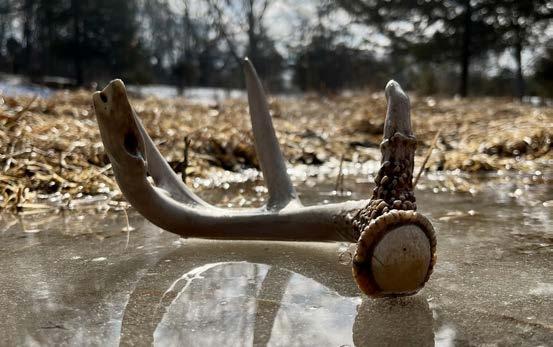 By: James Cole, Vice President of Lending
By: James Cole, Vice President of Lending
As you think about next year’s hunt, here are things to consider to help amplify your hunting experience.
Top Five Reasons to Buy Hunting Land
Owning your own hunting land is an opportunity to have a slice of peace and quiet away from the crowds to safely chase your next trophy whitetail. ■
STAY HYDRATED THIS WINTER
During the hot, humid summer months it’s easy to remember to keep your water bottle handy, but during the cold winter months, it’s an entirely different story. Experts say: make hydration a priority this winter, and your body will reward you.
Keep Your Water Bottle Full
Even a mild case of dehydration can lead to things like difficulty concentrating, poor memory, and even bad moods.
So, how much should you drink in a day? According to health experts, an average should be drinking about 3.7 liters and women should drink 2.7 liters.
Foods to Keep You Hydrated
It’s not just water that will help keep you hydrated.

Fruits like watermelon, strawberries, cantaloupe, and oranges are filled with water that can help keep you on track. For lunch, you may opt for a salad which can help, too. Lettuce, tomatoes, cucumber, and peppers all have high water content.
Technically, your warm cup of tea or afternoon soda also counts towards this hydration goal, but it’s recommended you stick to pure water as much as possible.
Your Skin Will Thank You
Have you ever experienced dryer and itchier skin during the frigid winter months in Michigan and Wisconsin? Chances are, that’s mostly due to dehydration.
You can put as much lotion and hand cream on as you want, but the truth is, it’s drinking water that’s going to help your dry skin the most.
Experts say people who drink the recommended amount of water each day are less likely to suffer from scars, wrinkles, and soft lines, too.
Keeping your skin healthy and beautiful is as simple as a few glasses of water.
Why am I dehydrated?
If the sun isn’t shining and you aren’t in high humidity, why exactly are you dehydrated during the winter?
Well, during this time, you’re probably wearing more clothing like heavy jackets. That clothing helps your body conserve heat, but it makes the body work between 10 and 40 percent harder. So, your body is producing more sweat and you’re losing more fluids.
In cold weather, we also lose more water through our respiratory system. When you can see your breath on a chilly winter day, that’s actually water vapor that your body is losing.
So, remember to make hydration a priority on your new year’s resolution list! ■
Commodity Cuisine...
Homemade Bread

Prep Time: 20 minutes
Rise time: 1 hour 30 minutes
Cook Time: 40 minutes
Ingredients
• 2 cups warm water 110 degrees F
• ½ cup white sugar
• 1 ½ tablespoons active dry yeast
• 1 ½ teaspoons salt
• ¼ cup vegetable oil
• 5-6 cups flour
Instructions
1. In a large bowl, dissolve the 1 TBSP of the sugar in warm water and then stir in yeast. Allow to proof until yeast resembles a creamy foam, about 5 minutes.
2. Mix remaining sugar, salt and oil into the yeast. Mix in flour one cup at a time. Dough should be tacky and clean the sides of the bowl. Note that too much flour will yield a dry loaf of bread; if you add too much, add a bit more hot water until you get the correct consistency.
3. Knead dough for 7 minutes. Place in a well oiled bowl, and tur n dough to coat. Cover with a damp cloth. Allow to rise until doubled in size, about 1 hour.
4. Punch dough down. Knead for 1 minute and divide in half. Shape into loaves and place into two greased 9×5 inch loaf pans. Allow to rise for 30 minutes, or until dough has risen 1 inch above pans.
5. Bake at 350 degrees F for 30-40 minutes. Cool, brush with butter and enjoy!
Source: butterwithasideofbread.com/homemade-bread ■
CRAFTING AWAY THE WINTER BLUES
While your family is stuck inside this winter, it can be the perfect opportunity to try your hand at a new craft! From sewing, to scrapbooking and everything in between, there are endless opportunities to find a craft that the whole family can enjoy together.

Utilizing items that you most likely already have lying around your home, gather the family to make these beautiful snowflake suncatchers.
Here’s what you will need:
• Scissors
• A sheet of paper for each snowflake you would like to make
• Assorted colors of tissue paper
• Clear contact paper or Press’n Seal wrap
Making your snowflake
1. Fold one cor ner of your sheet of paper to the opposite side of the page to form a triangle.
2. Cut the excess strip of paper from the top of the triangle.
3. Fold your triangle in half to form another triangle.
4. Fold one side of your triangle toward the middle to form a point at the bottom, and then fold the other side of your triangle to overlap it.
5. Cut the top of your newly formed triangle to remove the points.
6. Now the real fun begins! Cut shapes out of the folded paper to create your own unique design.
7. Unfold to reveal your beautiful snowflake!
Transforming your snowflake into a suncatcher
1. Cut your tissue paper selections into small squares.
2. Grab your snowflake and press it onto your clear contact paper or Press’n Seal wrap.
3. Now fill in the empty spaces of the snowflake with your tissue paper squares.
4. Upon completion, cover the tissue paper side of your snowflake with another piece of clear contact paper or Press’n Seal wrap.
5. Cut around the edge of your snowflake to remove the excess sealant.
You have now successfully completed your snowflake suncatcher! Hold them up to the light or hang them on the window to fully enjoy your beautiful creation. If you try this DIY, tag us on social media so we can reshare your cool craft! ■
CROP INSURANCE NEWS:

MULTI-COUNTY ENTERPRISE UNITS
RMA now allows a single Enterprise Unit (EU) structure that covers two adjoining counties. It is only available when authorized on the actuarial documents for crops which Revenue Protection (RP) is available. One county must individually qualify for EU as the primary and the other county must not qualify for EU. MCEU must be elected on or before the SCD and electing MCEU does not automatically make the county eligible MCEU. ■
POWER OF ATTORNEY (POA) AND SIGNATURES
ACCOUNTING & BILLING
Premium bills were due before October 1. Starting with the earliest premium bill date, payments are applied as follows: a) any unpaid finance or interest charge, b) unpaid administrative fees, and c) unpaid premiums. Please keep in mind that accrued interest on uncollected premium is attached, according with the terms of the Standard Reinsurance Agreement, and cannot be waived by the agent or AIP. If you cannot pay your premium before the March 15th Debt Termination Date, contact the AIP directly to set up a payment plan. Otherwise, you won’t be eligible for crop insurance or any other federally subsidized programs. ■
Crop insurance documents requiring a signature must be signed by an authorized person. The Crop Insurance Handbook says that for a spouse or others to sign for the insured, they must be authorized by a POA or other legally sufficient document. Even if the person is listed as an SBI on the application. Signature statements on the Application or Policy Change Form can serve as a legally sufficient document. For specific details, please consult your Specialist. ■
DRY BEAN PREVENTED PLANTING COVERAGE LEVEL CHANGES
EARLY / LATE PLANT DATES
Early and late plant dates may have changed and vary by location within the state. Be sure to contact your GreenStone crop insurance specialist to get the specific dates for your area. It is important to note that crop acreage planted before the early plant date is not eligible for replant payments but will still be eligible for insurance coverage. The insurance guarantee is not impacted as long as producers follow good farming practices. Crops planted after the late plant date during the late plant period will also have reduced coverage. ■
PP Coverage levels for dry beans has been reduced from 60% coverage down to 50%. Prevented planting coverage levels have changed for many other crops in recent years. See your agent for the most current levels and options for PP coverage. ■

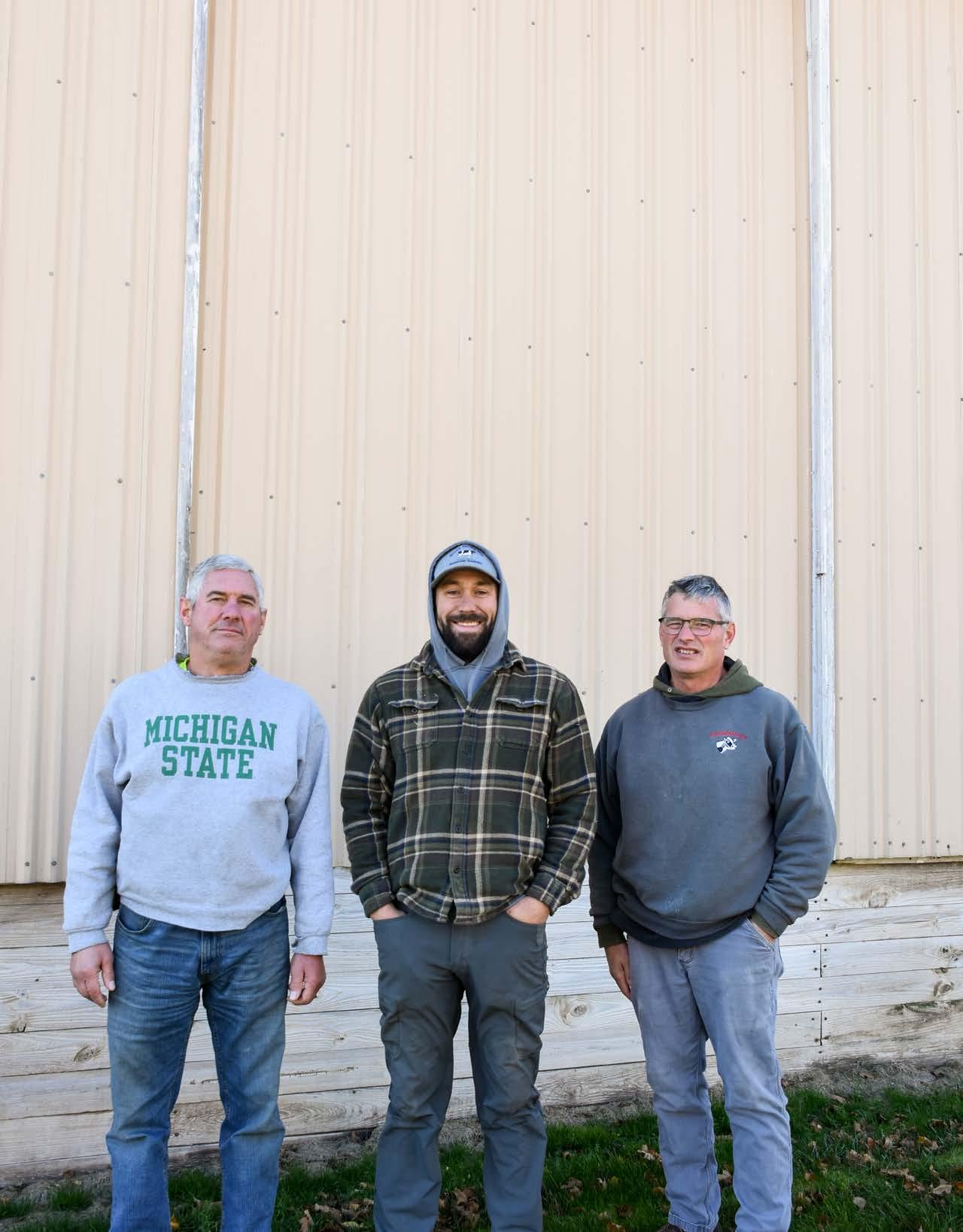
It started in 1926 when Phil and Steve’s grandfather, Charles Gross, bought some cattle. The farm grew and milk was leaving the property by the gallon.
In 1947, the farm was passed down to Charles’ son, Norman, the father of Phil and Steve. The two boys grew up on the dairy farm where they fell in love with taking care of cattle, and they wouldn’t have it any other way.
“You’re born into the industry and you realize that you enjoy it and you really don’t want to do anything else,” said Steve. “I know it sounds simple, but that’s how it goes.”
“We grew up on the farm,” said Phil. “As kids, we didn’t have a choice. We had to do it whether it meant we were missing out on some stuff or not. As an adult, you look back on it and realize you weren’t missing out on a whole lot.”
The two began running the farm from their father during the 2000’s, and fully took over after the passing of their dad in 2015.
A New Phase
For Steve and Phil, keeping up with the times and making sure they can embrace their passion while turning a profit is important. They made the tough decision to move in a different direction with their farm and transitioned from a dairy farm to cash crops.
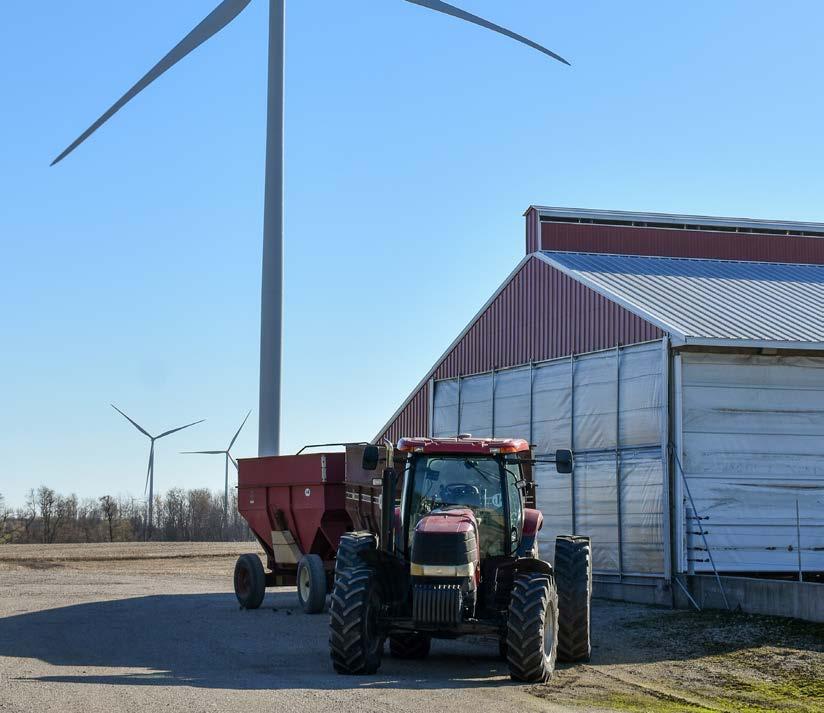
➡
Left : Phil (L), Steve (R) and their nephew Kevin work hard to keep the cattle and crops taken care of on their family farm.
➡
Right: The Gross family finished up harvesting their crops in the fall.
View a highlight reel video at: www.greenstonefcs.com/CropWinter23
They began selling their cattle in August. Right now, there’s still a couple of cattle barns left as they continue the transition.
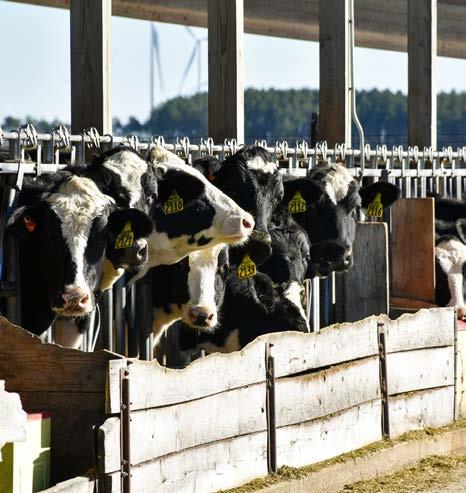
“Nothing happens overnight but we definitely have some more ideas of the direction we want to move the farm in,” said Steve.
As a part of this transition, the brothers began expanding the crops they grew this past year. In the fall, the two finished up harvesting corn, wheat, alfalfa, and soybeans.
For nearly 100 years, the Gross family in Weidman, Michigan near Mount Pleasant has been running a full dairy operation.
The GreenStone Difference
This big transition to being crop only, means it’s even more important their crops are protected.
After working with GreenStone in the past to secure land and operational loans, the brothers wanted their crop insurance to come from the same place.
“We were working with GreenStone for years, so it made sense to do everything with GreenStone,” said Phil.
The two then worked with crop insurance specialist Jordan Schafer to come up with a coverage plan that works for their needs. It’s a relationship that was years in the making.

“The relationship formed over the years,” said Jordan. “I kept in touch with them over the past three to four years. I supplied them with information about different programs incorporated with crop insurance that could benefit them.”
Jordan used a program called Optimum for this analysis – a tool exclusive to the
“
Farm Credit System crop insurance teams. Crop insurance specialists like Jordan enter information about a specific farm into the program and put the farm through different scenarios, like weather events. This helps customers learn about the best crop insurance plan options for their land.
Because of this tool, the brothers decided to get hail protection implemented into their plan because of issues they had in the past.
“With weather the way it is, we grow white wheat that is a little more touchy and we just wanted more protection,” said Steve. “There’s
With weather the way it is, we grow white wheat that is a little more touchy and we just wanted more protection... There’s hail that comes through periodically so we are happy to have that coverage.➡ Crop Insurance Specialist Jordan Schafer makes a visit to the Gross farm. He has worked closely with the brothers to help them protect their crops.
hail that comes through periodically so we are happy to have that coverage.”
Steve and Phil are happy to know that Jordan comes from a farming background and has their best interest in mind.
“Jordan has been really helpful in figuring out the level of coverage we need for our acreage,” said Steve. “He has been a really big help with our operation.”
“Jordan is a straight-shooter and tells us how it is and we appreciate that,” said Phil. “It helps that he has an agriculture background. He isn’t trying to sell us high in the sky, he’s down to earth and understands our operation.”
Family by Their Side
Although Steve and Phil are the brains behind the operation, they couldn’t do it without the help of their family.
Their nephew, Kevin, works alongside them. They hope, one day, he will be able to take the farm over when they decide to hang up their hats.
“The goal is to transition the farm over to the next generation,” said Phil.
Although Steve and Phil’s children aren’t employees of the family farm, they’re not afraid to come back and lend a hand.
“It works out. It’s give and take but we all
have our jobs to do. Our kids will come back and help out when they get done with their main jobs,” said Steve. “They might not be full-time employees on the farm, but they come back and help out when needed.”
The Road Ahead
Over the next couple of years, the brothers hope to completely transition out of dairy and expand their fields.
One day, they want to have enough grain storage to be able to sell some crops on-site.
For now, the two will continue leaning on each other until the cows come home, or, find a new home.
“We’ve been able to keep it going during good and bad years, but the good always outweighs the bad,” said Steve.
“Some brothers don’t get along very well with each other, but we have made it work,” said Phil.
And Jordan will keep visiting the farm to help them keep those prized crops protected.
“It’s good of them to keep innovating everything on the farm and surrounding themselves with resources on their farm to help them take every step they can to succeed. I want to be that resource for them,” said Jordan. ■
CONTRACT PRICE ADDENDUM
The Risk Management Agency offers a contract price addendum that would allow a producer who receives a contract price for their crop to receive a crop insurance guarantee that is more reflective of the actual value of the crop. Under the addendum, insured producers would have the ability (where available and by choice) to use their personal contract price as their price election, or to use the existing crop insurance price election. If you grow specialty crops under contract and are interested in possibly using your contract price to set your crop insurance guarantee, make sure to ask your crop insurance specialist about the new contract price addendum. ■
ORGANIC CROPS
As a reminder, the USDA Risk Management Agency now requires all insured organic certified producers to provide a copy of their organic crop plan and organic certificate to their agent before the acreage reporting date. ■
PERSON TYPES & IDENTIFICATION NUMBERS

To better accommodate data reconciliation between the Farm Service Agency & RMA, there have been some changes made to the social security number and employer identification reporting requirements for individuals, estates and trusts. If you have recently made a change in how an entity has been set up, let your crop insurance specialist know and they will make sure your policy is renewed using the correct identifying numbers. These records need to be updated before the March 15th deadline. ■
Crop Insurance Calendar...


JANUARY MARCH APRIL
15 15 29
Fruit Acreage Reports / Yield Reports & Pre-Acceptance Worksheets Due





Final date to sign up or make changes for a Spring 2023 crop insurance policy. If you are interested in changing the coverage level, type or need to add a crop, please call your crop insurance specialist to review your options. Any and all changes need to be completed by the March 15th deadline! If a signed application is not returned, your policy will automatically renew at the same level you insured at during the previous year.
Production reporting deadline for Fall 2022 harvested crops. Before you get busy in the field this spring, be sure to have your production reports completed, signed and submitted before April 29th.
*Please note that some dates can vary by county, especially in Wisconsin. Please check with your crop insurance specialist for specific dates if you are unsure.
As of the writing of this article, GreenStone’s tax and accounting department is busy meeting with farmers across Michigan and northeast Wisconsin to help each customer manage taxable incomes and to support our farmers in making wise management decisions for current and future farming operations – reducing taxable income levels where it is possible and makes sense by buying equipment, prepaying for inputs, carrying over crops, or using other tax planning strategies available. It has been extremely busy this year with the commodity prices that most of our farmers were fortunate to experience!
When you are reading this article, we are now into 2023 and it is too late to buy inputs or equipment to reduce 2022 taxable income. However, there is another play that can still be run come income tax filing time this year – that is to utilize farm income averaging via the Schedule J Internal Revenue Service Form.

Our tax accountant experts anticipate the use of farm income averaging to increase this year – farm taxable income levels have been relatively strong the last year few years due to commodity prices and significant government aid. Many farmers have utilized accelerated depreciation methodologies such as Section 179 or bonus depreciation in the past few years to manage taxable income levels down.
After a few years of strong results, rising equipment borrowing rates, continued supply chain issues in the equipment market, and questions of potential increases in income tax rates in the future - it may feel like you are running out of rope and can no longer (or no longer want to) continue kicking income tax burdens down the road. Farm income averaging may assist you this year if you will be paying income tax.
What is farm income averaging? It is a federal statute that allows farmers to spread a portion of their current year farming income equally over the three previous tax years. By averaging an income tax burden over several years, you can reduce the effects of both low and high taxable income years. This can be done using the aforementioned IRS form 1040 Schedule J.
How does it work? Below is a simplified computation showing the impact of farm income averaging for a married filing jointly 1040 return. The example assumes that the farmer’s taxable income for 2022 is $323,800 and that 2021, 2020 and 2019 were all managed to $0. With this fact pattern if farm income tax averaging were not used, the farmer would have paid the following tax each year:
With the use of farm income averaging during the 2022 tax filing, a farmer could assign between $78,950 and $81,050 to 2019 through 2021 to soak up all of the 10% and 12% tax brackets for those years. When filing the 2022 tax return, you act like the
farmer paid the respective tax for each year and add those taxes to the remaining amount taxed in 2022. This is how it would look in the simplified scenario:
Taxable Income 83,550 81,050 80,250 78,950 323,800 Total tax 9,615 9,328 9,235 9,086 37,264
As you can see, the effective tax rate drops from 20.2% to 11.5% via the utilization of income averaging. It results in permanent tax savings of $28,119.
What can you do? The IRS has been friendly to farmers with this statute – it is flat out a great provision for farmers. This is something you should bring it up to your CPA or income tax professional this year to see if it is an option for your individual situation. The rules can be complicated and this article is a simplified example. However, you’ll want to at least ensure it is being considered when you complete this year’s income tax filings.
If you are interested in learning more about anything you read within this article, contact your CPA or a local GreenStone tax accountant. GreenStone offers a full array of tax and accounting services for farmers and other business owners and we are ready to assist you with your income tax filing needs. ■
Tax Calendar...
JANUARY
Individuals make a payment of your estimated tax for 2022 if you didn't pay your income tax for the year through withholding (or didn't pay in enough tax that way) via Form 1040-ES.
Farmers and fishermen pay your estimated tax for 2022 using Form 1040-ES – if you pay your tax in full, you have until April 18 to file your 2022 income tax return. If you don't pay your estimated tax by January 17, you must file your 2022 return and pay any tax due by March 1, 2023 to avoid an estimated tax penalty.
Form 1099 due to recipients of certain payments made during 2022 for interest, rent, contract labor, veterinarian services, etc., including the new 1099-NEC Form.
Provide employees copy of Form W-2 for 2022.
Farm employers file Form 943 to report social security and medicare wages, and withholdings. Non-farm employers file Form 941 for the 4th quarter to report social security and Medicare wages, and withholdings.
Employers file Form 940 for federal unemployment tax.
Payers must file Forms 1099 and 1096 (other than 1099-NEC, which is due January 31) with the IRS. If these forms are e-filed, the deadline is extended to March 31.
Qualifying farmers file individual tax return (Form 1040) and pay tax due if no safe estimated tax amount paid in and owe over $1,000 in tax.
S Corporations file a 2022 calendar year income tax return (Form 1120S). Provide each shareholder with a copy of Schedule K-1. If not able to file, file Form 7004 to request an automatic six month extension.
Partnerships and LLC’s taxed as a partnership file a 2022 calendar year return (Form 1065). Provide each partner with a copy of Schedule K-1. If not able to file, file Form 7004 to request an automatic six month extension.
Individuals file a 2022 income tax return (Form 1040) and pay any tax due. If not able to file, file Form 4868 to request an automatic six month extension. Any tax due must be paid with the extension.
First quarter estimate is due for 2023 for individuals paying estimated taxes.
C Corporations file a 2022 calendar year tax return (Form 1120) and pay any tax due. If not able to file, file Form 7004 to request an automatic six month extension. Any tax due must be paid with the extension.
C Corporations deposit the first installment of estimated income tax for 2023.
iTech Tip: Family Account and sharing
By: Matthew Cosgrove GreenStone VP of Information SecurityAccording to a Common Sense Census, the use of screen media is up 17% for tweens and teens from 2019 to 2021 – growing more than the previous four years prior (Common Sense Media, 2022).
Children between the ages of 8 and 12 are on their devices for an average of 5 hours and 33 minutes a day. Kids are spending almost 3 hours a day watching online videos, one and a half hours playing games and an hour browsing websites and on social media sites.
Your child may have recently opened a new tablet, mobile phone or even game console at Christmas. All these devices provide internet access to your child. While we trust our children, it is tough as a parent to know what your child is doing and who they might be communicating with online. With any online access there are risks, like accessing inappropriate content and bullying. Social media apps and websites also pose risks, predators might pose as children to get your child to provide personal information like their address or phone number.
As parents we must be aware of what our children are doing online and talk with them, letting them know what is appropriate to say to people they might meet online. I tell my children that information like their real name, address, and phone number is never information we provide people online. We only give that information to people that we know in real life (IRL). While this might seem overwhelming, there are free tools that go a long way in helping protect your child online and providing us parents peace of mind.
Children’s Online Privacy Protection Act
In 1998 the federal government passed the Children's Online Privacy Protection Act (COPPA) (Federal Trade Commission, n.d.). This rule imposes requirements on website or online services that they must require parental consent for the collection or use of any personal information of children under 13 years of age. Sites like Microsoft and Google require parents to make a small payment to verify that you consent to your child using their service. COPPA provided parents with tools to help make sure they have explicit control over their child’s personal information.
Family Accounts / Sharing

A number of online services that we use provide families with the ability to create and manage accounts for their children and in some instances, families can even share the features of their subscription. Family accounts allow parents to create and
manage the online accounts for their children. This provides parents the ability to set
restrictions on what the child account can access; as an example, Apple offers family sharing. This allows parents to restrict applications, games, TV shows and movies based on the child’s age and even pose time restrictions on the device. Microsoft and Google both offer similar types of features that parents can take advantage of to help supervise what their children can do and see online. These types of restrictions even exist on video streaming services like Netflix and Hulu where parents can create specific child profiles that restrict their access to content that would otherwise have been inappropriate for them.
These features can be challenging to implement and frustrating for parents, and typically not well received by our children. Some parents have instead decided to move the family computer into a room where they are able to see what their child is doing online; however, this has become
harder because kids are accessing the internet from the devices they keep in their pocket or room.
Taking advantage of some of the services and account management tools available help provide parents with a peace of mind knowing that they are doing everything in their power to protect their child. With the amount of time our children are spending online, you want to make sure that they are safe.
References
Common Sense Media. (2022, March 9th).
The Common Sense Census: Media Use by Tweens and Teens, 2021. Retrieved from www.commonsensemedia.org
Federal Trade Commission. (n.d.). Children's Online Privacy Protection Rule ("COPPA"). Retrieved from www.ftc.gov/legal-library ■
As parents we must be aware of what our children are doing online and talk with them, letting them know what is appropriate to say to people they might meet online.
“
3515 West Road
East Lansing, MI 48823
Winter feature highlight...
When our members are successful, we’re successful; and once again that partnership is realized through Patronage!
Read more on page 18.
